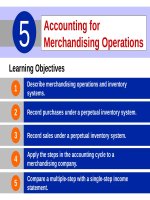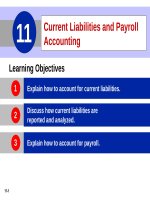Accounting principles 10e by kieso chapter 09
Bạn đang xem bản rút gọn của tài liệu. Xem và tải ngay bản đầy đủ của tài liệu tại đây (1.58 MB, 66 trang )
9-1
CHAPTER9
Accounting for
Receivables
9-2
PreviewofCHAPTER9
9-3
Types of Receivables
Amounts due from individuals and other companies that are
expected to be collected in cash.
Amounts owed by
customers that
result from the sale
of goods and
services.
Claims for which
formal instruments
of credit are issued
as proof of debt.
Accounts
Accounts
Receivable
Receivable
Notes
Notes
Receivable
Receivable
9-4
“Nontrade” (interest,
loans to officers,
advances to
employees, and
income taxes
refundable).
Other
Other
Receivables
Receivables
SO 1 Identify the different types of receivables.
Types of Receivables
Amounts due from individuals and other companies that are
expected to be collected in cash.
Illustration 9-1
9-5
SO 1 Identify the different types of receivables.
Accounts Receivables
Three accounting issues:
1. Recognizing accounts receivable.
2. Valuing accounts receivable.
3. Disposing of accounts receivable
Recognizing Accounts Receivable
9-6
Service organization - records a receivable when it
provides service on account.
Merchandiser - records accounts receivable at the
point of sale of merchandise on account.
SO 2 Explain how companies recognize accounts receivable.
Accounts Receivables
Illustration: Assume that Jordache Co. on July 1, 2012, sells
merchandise on account to Polo Company for $1,000 terms
2/10, n/30. Prepare the journal entry to record this transaction
on the books of Jordache Co.
Jul. 1
Accounts receivable
1,000
Sales revenue
1,000
9-7
SO 2 Explain how companies recognize accounts receivable.
Accounts Receivables
Illustration: On July 5, Polo returns merchandise worth $100
to Jordache Co.
Jul. 5
Sales returns and allowances
100
Accounts receivable
100
Illustration: On July 11, Jordache receives payment from
Polo Company for the balance due.
Jul. 11
Cash
882
Sales discounts ($900 x .02)
18
Accounts receivable
900
9-8
SO 2 Explain how companies recognize accounts receivable.
9-9
Accounts Receivables
Valuing Accounts Receivables
Current asset.
Valuation (net realizable value).
Uncollectible Accounts Receivable
9-10
Sales on account raise the possibility of accounts not
being collected.
Seller records losses that result from extending credit as
Bad Debts Expense.
SO 3 Distinguish between the methods and bases
companies use to value accounts receivable.
Accounts Receivables
Methods of Accounting for Uncollectible Accounts
Direct Write-Off
Theoretically undesirable:
Allowance Method
Losses are estimated:
No matching.
Better matching.
Receivable not stated at
cash realizable value.
Receivable stated at cash
realizable value.
Not acceptable for
financial reporting.
Required by GAAP.
9-11
SO 3 Distinguish between the methods and bases
companies use to value accounts receivable.
Accounts Receivables
How are these accounts presented on the Balance Sheet?
Accounts Receivable
Allowance for
Doubtful Accounts
Beg.
500
25
Beg.
End.
500
25
End.
9-12
Accounts Receivables
9-13
Accounts Receivables
9-14
Alternate
Presentation
Accounts Receivables
Journal entry for credit sale of $100?
Accounts receivable
100
Sales
Accounts Receivable
100
Allowance for
Doubtful Accounts
Beg.
500
25
Beg.
End.
500
25
End.
9-15
Accounts Receivables
Journal entry for credit sale of $100?
Accounts receivable
100
Sales
Accounts Receivable
Beg.
500
Sale
100
End.
600
9-16
100
Allowance for
Doubtful Accounts
25
Beg.
25
End.
Accounts Receivables
Collected $333 on account?
Cash
Accounts receivable
Accounts Receivable
Beg.
500
Sale
100
End.
600
9-17
333
333
Allowance for
Doubtful Accounts
25
Beg.
25
End.
Accounts Receivables
Collected $333 on account?
Cash
Accounts receivable
Accounts Receivable
Beg.
500
Sale
100
End.
267
9-18
333
333
333
Allowance for
Doubtful Accounts
25
Beg.
25
End.
Coll.
Accounts Receivables
Adjustment of $15 for estimated bad debts?
Bad debt expense
15
Allowance for Doubtful Accounts
15
Accounts Receivable
Beg.
500
Sale
100
End.
267
9-19
333
Allowance for
Doubtful Accounts
25
Beg.
25
End.
Coll.
Accounts Receivables
Adjustment of $15 for estimated bad debts?
Bad debt expense
15
Allowance for Doubtful Accounts
15
Accounts Receivable
Beg.
500
Sale
100
End.
267
9-20
333
Coll.
Allowance for
Doubtful Accounts
25
Beg.
15
Est.
40
End.
Accounts Receivables
Write-off of uncollectible accounts for $10?
Allowance for Doubtful accounts
10
Accounts receivable
10
Accounts Receivable
Beg.
500
Sale
100
End.
267
9-21
333
Coll.
Allowance for
Doubtful Accounts
25
Beg.
15
Est.
40
End.
Accounts Receivables
Write-off of uncollectible accounts for $10?
Allowance for Doubtful accounts
10
Accounts receivable
10
Accounts Receivable
Beg.
500
Sale
100
End.
9-22
257
333
Coll.
10
W/O
Allowance for
Doubtful Accounts
W/O
25
Beg.
15
Est.
30
End.
10
Accounts Receivables
9-23
Accounts Receivables
Direct Write-off Method for Uncollectible Accounts
Illustration: Assume that Warden Co. writes off M. E. Doran’s
$200 balance as uncollectible on December 12. Warden’s
entry is:
Bad debts expense
Accounts receivable
200
200
Theoretically undesirable:
9-24
No matching.
Receivable not stated at cash realizable value.
Not acceptable for financial reporting.
SO 3
Accounts Receivables
Allowance Method for Uncollectible Accounts
1. Companies estimate uncollectible accounts
receivable.
2. Debit Bad Debts Expense and credit Allowance for
Doubtful Accounts (a contra-asset account).
3. Companies debit Allowance for Doubtful Accounts
and credit Accounts Receivable at the time the
specific account is written off as uncollectible.
9-25
SO 3 Distinguish between the methods and bases
companies use to value accounts receivable.









